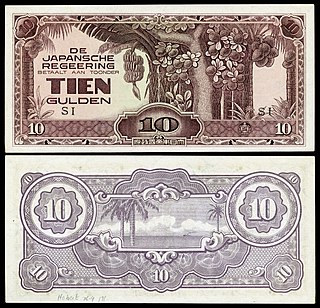The Japanese-issued Netherlands Indies gulden was the currency issued by the Japanese Empire when it occupied the Dutch East Indies during World War II. Following the Dutch capitulation in March 1942, the Japanese closed all banks, seized assets and currency, and assumed control of the economy in the territory. They began issuing military banknotes, as had previously been done in other occupied territories. These were printed in Japan, but retained the name of the pre-war currency and replaced the Dutch gulden at par. From 1943 the military banknotes were replaced by identical bank-issued notes printed within the territory, and the currency was renamed the roepiah from 1944. The currency was replaced by the Indonesian rupiah in 1946, one year after the Japanese surrender and the country's independence.
This note, denominated ten gulden, is part of the 1942 series.
See other denominations: One cent · Five cents · Ten cents · Half gulden · One gulden, Five gulden, Ten guldenBanknotes: Empire of Japan. Reproduction: National Numismatic Collection, National Museum of American History at the Smithsonian Institution

Well, that’s interesting to know that Psilotum nudum are known as whisk ferns. Psilotum nudum is the commoner species of the two. While the P. flaccidum is a rare species and is found in the tropical islands. Both the species are usually epiphytic in habit and grow upon tree ferns. These species may also be terrestrial and grow in humus or in the crevices of the rocks.
View the detailed Guide of Psilotum nudum: Detailed Study Of Psilotum Nudum (Whisk Fern), Classification, Anatomy, Reproduction